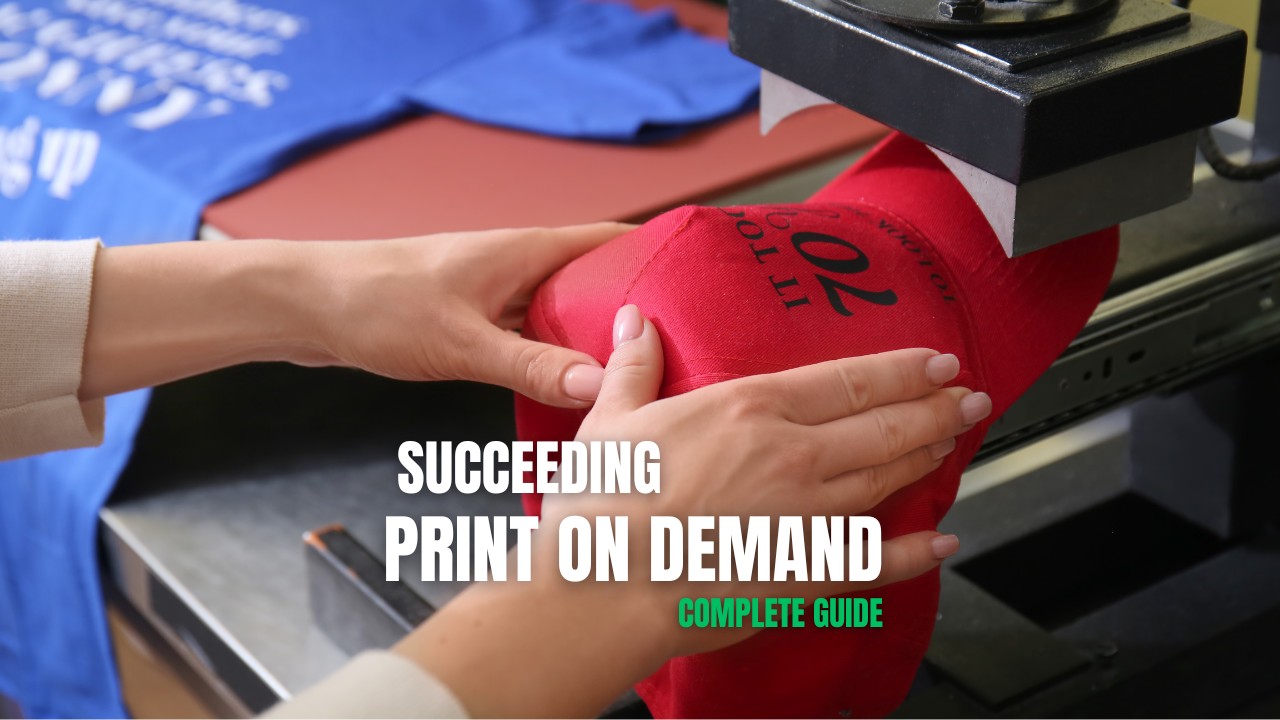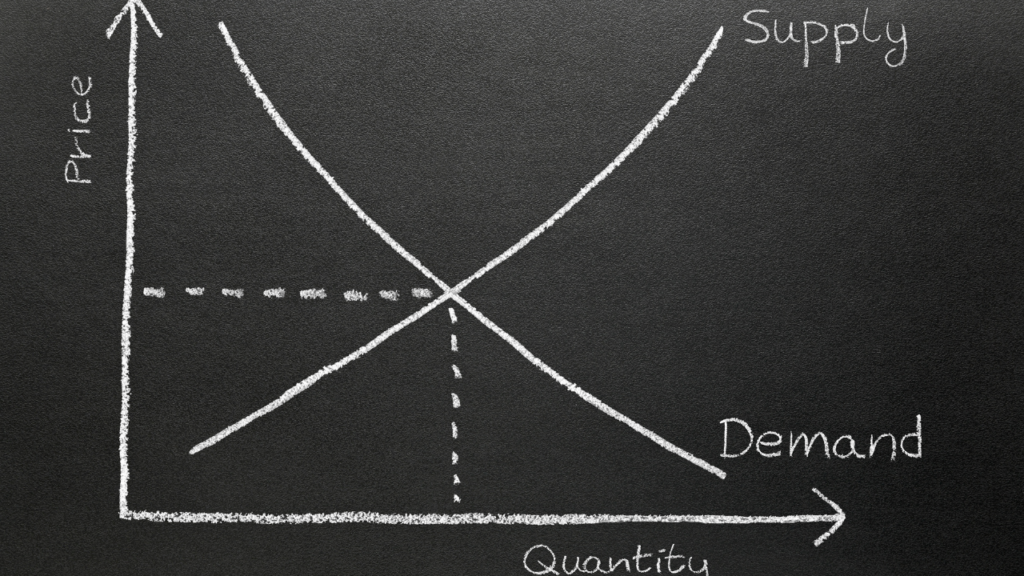
What do your favorite band’s concert T-shirt, the company-branded mug you received on your first day at work, and the poster you purchased from an illustrator you follow on Instagram all have in common? There’s a strong likelihood that each of these items was created through print on demand.
Introduction
If you’re interested in diving into the world of selling personalized print on demand products, our comprehensive guide is an excellent starting point. Feel free to browse through the table of contents or read it all in one go!
1. What is print on demand?
Increasingly popular over the past decade, print on demand has sparked a true revolution in the world of e-commerce.
1.1. Definition
Print on Demand, also known as POD or print on demand, is a business model that enables you to sell your own custom designs on various types of products (T-shirts, mugs, tote bags, caps, etc.) under your own brand label.
Your print on demand provider prints your design on a product only after receiving an order. This means you don’t pay for the product until it’s sold, eliminating the need for stocking inventory and making an initial investment.
Furthermore, once a sale is made, your POD service takes care of everything, from printing to shipping. The process is 100% automated.
1.2. Differences between print on demand and dropshipping
Similar to dropshipping, with print on demand, you don’t need to purchase large quantities of products when you start. Products are printed only once they are ordered. So, what’s the difference between these two order management methods?
Dropshipping is a model that involves selling products online without physically holding them in stock. This order management system doesn’t necessarily involve customization. It can, for example, entail reselling inexpensive watches purchased from Aliexpress.
Print on demand involves selling personalized products with your custom designs under a white label without physically stocking them. For instance, selling merchandise, products featuring your logo, or your creations printed on clothing. Unlike dropshipping, POD entails a process of printing a design onto clothing or accessories.
Print on demand is, therefore, a variant of dropshipping with a higher degree of personalization. In recent years, an increasing number of brands have been offering customization options to their customers. Louis Vuitton, for example, provides the opportunity to add a personalized monogram to their luggage.
Much like dropshipping, POD serves as a launching pad for entrepreneurship due to its accessibility. But is it really suitable for everyone?
2. Who is print on demand for?
Print on demand isn’t limited to a specific profile; it’s open to businesses, individuals, celebrities, and a diverse range of people. Anyone seeking to earn extra income can venture into print on demand.
Print on demand caters to a wide range of individuals and entities; it’s not limited to any specific profile. It’s accessible to businesses, individuals, celebrities, and more. Diverse profiles can partake in print on demand, making it an option for anyone looking to increase their income.
2.1. For Creators
Print on demand is ideal for creating merchandise (or derivative products) for creators (YouTubers, influencers, gamers, etc.) who already have a fanbase. It’s an excellent way to monetize your audience.
2.2. For Entrepreneurs and Graphic Designers
Do you want to start a business with minimal risk? Are you a freelance graphic designer looking to market your designs on custom products? If you’re creative and have marketing skills, POD is perfect for you. All you need is a niche idea and/or a design to get started!
2.3. For Businesses and Individuals
- Single orders
Print on demand allows you to create unique personalized gifts with your own designs or photos, without any minimum order requirements. Gift a personalized onesie to your nephew or a customized mug to your grandmother as a Christmas or birthday present!
- Bulk Orders
It’s also the ideal gift for a group celebration or event, such as a bachelorette party or team building event.
With Printful, you can save up to 30% by ordering more than 25 items for your friends, team, or events. It’s simple: the more you order, the more you save! Check out our bulk ordering page.
Do you identify with one or more of these categories? If so, keep reading this article!
3. What Are the Pros and Cons of Print on Demand?

Every printing technique has its advantages and disadvantages, and POD is no exception.
3.1. Advantages of Print on Demand

Let’s start with the main advantages of print on demand:
- No Inventory: The concept of print on demand is the opposite of mass production logic. Each product is printed only after it’s ordered, so you won’t end up with unsold stock.
- Low Investment: With POD, you don’t need to invest in expensive equipment like a printer. The provider handles the production aspects, such as printing or embroidering designs on items. You only need a computer and an internet connection to refine your online storefront and promote it through a marketing strategy. Learn more about the costs of a POD business.
- Low Risk: Not holding physical inventory gives you great flexibility to test new design ideas, as you have nothing to lose if you don’t make sales. You can experiment with different designs or types of products.
- Order Management and Logistics Handled by the Provider: Your POD provider is more than just a supplier; they take care of printing, packaging, and shipping for every order. The degree of customization varies from one provider to another, but everything is designed so that your end customer doesn’t realize their order was processed by a third-party provider. In short, working with a print on demand provider allows you more time to focus on your marketing strategy.
3.2. Disadvantages of Print on Demand
Now, let’s move on to the main disadvantages of print on demand.
- Higher Cost per Item: Since print on demand is based on single or small-volume orders, the cost of products is higher than for bulk orders. However, you set your prices based on the profit margin you want to achieve. It’s up to you to offer attractive designs and promote them effectively.
- Longer Processing Times: Products need to be manufactured before they’re shipped, so lead times are longer because you have to add the order processing time to the delivery time. Our average order processing time is 3 business days, plus an average of 4 days for shipping.
- Dependence on the Provider: The provider handles your order management and shipping, so you won’t see your products. Therefore, it’s crucial to order samples of your products before you start selling. This way, you can ensure the product and print quality meet your expectations.
In summary, avoid putting all your eggs in one basket by diversifying your product catalog. To sum it up, print on demand allows you to experiment with new ideas without taking risks. However, keep in mind that processing orders as they come in involves longer lead times.
4. How to Start in Print on Demand?
Now that you’re familiar with the pros and cons of print on demand, let’s move on to the steps to get started in print on demand.
4.1. How to Choose a Print on Demand Provider?
Selecting the right print on demand provider is essential for success because their role extends beyond just producing items.
Criteria for Choosing a Print on Demand Provider
We’ve identified five important criteria to help you choose your print on demand provider:
- Delivery
- Printing quality
- Degree of customization
- User experience
- Product catalog
Printful: The Most Comprehensive Print on Demand Provider
Printful offers a wide range of customizable products and numerous features, with the most iconic being the Design Maker. Whether you want to sell clothing, posters, or interior decoration accessories, you’ll find what you’re looking for in the catalog.
Let’s apply our five criteria to Printful:
- Delivery
There are four factors to consider: order processing time, delivery time, the order processing and shipping location, and shipping rates.
- Order processing time is the time it takes to print the design on the product. It’s 2-7 business days for clothing and 2-5 business days for other products.
- The average delivery time for orders is 4 days, but it varies depending on the production center from which the order is shipped.
- The order processing and shipping location is an important factor. Printful has a production center in Barcelona. If you’re selling only to customers based in France, when choosing your products, filter by the processing and shipping location. In addition to enjoying short delivery times, you won’t have to pay customs duties. Note that Printful also offers print on demand products in Canada.
- Printful’s shipping rates are fixed and calculated based on the average shipping cost for each product category. Calculate shipping rates based on the destination, product type, and quantity using our calculator.
- Printing
At Printful, we use various printing techniques depending on the product. We print most of our T-shirts using direct-to-garment (DTG) printing, but we also offer screen printing. Depending on the materials and designs you want, follow these tips to ensure a successful print file.
- Degree of Customization
Printful offers the option to customize your inner labels and packing slips for an additional fee. You can also include pack-ins like stickers, business cards, or brochures with your orders.
- User Experience
With an integrated Mockup Generator, you can bring your ideas to life in minutes, creating realistic product images for your online store and marketing materials. Furthermore, Printful offers a wide range of integrations with marketplaces and e-commerce platforms such as Shopify or Amazon. You can also utilize a custom API.
- Product Catalog
Printful offers a regularly updated catalog of 341 products, including prestigious brands like Champion, American Apparel, Bella + Canvas, and Gildan. Printful’s catalog encompasses clothing, promotional items, and decorative products.
4.2. How to Choose Your Print on Demand Niche?
Before you start creating your designs, identify your target audience. Who do you want to sell your products to?
Here are some tips for finding a profitable print on demand niche:
- Position Yourself in a Community You Belong To
- It’s always easier to sell to a niche that you’re already familiar with. You know their conventions, jargon, and consumer habits.
- Target a Niche with Low Competition
- Conduct market research to anticipate trends. For instance, analyze keyword search volume by entering relevant terms in the Google search bar.
- It’s about finding the right balance: if your niche is too broad, you won’t be able to target it effectively; if it’s too small, you won’t have enough buyers. In other words, assess the commercial potential of your niche.
Need inspiration? Discover 100 niche ideas.
- Explore Product Categories on Marketplaces
You want to focus on the automotive/motorcycle industry? That’s a good starting point, but this target is still too broad. To delve deeper into this theme, take a look at the major marketplaces (Amazon, Cdiscount, Aliexpress, etc.) and explore the subcategories and best-selling products.
Let’s say the “scooter” sub-category, especially electric scooters, interests you.
You can conduct a search on Google Trends to assess the trend in interest for scooters over a specific period.
It’s evident that electric scooters have been trending in France since 2018. The next step is to analyze this community by checking forums and Facebook groups to find an angle for your print-on-demand online store.
4.3. How to create designs
Undoubtedly, design plays a crucial role when it comes to creating custom print-on-demand products. The most challenging part is finding a design that is both original and commercially viable. But here’s the good news: you don’t need to be a graphic designer to create designs.
If you already have some graphic design knowledge, you can create your T-shirt designs with Photoshop or an alternative.
If you’re not comfortable with Photoshop, but your design idea is relatively simple, you can use Printful’s Design Maker. It offers a wide range of designs, fonts, illustrations, cliparts, and symbols that can be freely used. This is ideal if your design idea is straightforward!
Lastly, you can always hire a freelance graphic designer to bring your design ideas to life or check out our article for design inspiration.
4.4. How to sell your print on demand products?
There are multiple marketing strategies to sell online, and the most effective ones are not necessarily the most costly; quite the opposite.
Here are three ideas for almost free marketing strategies to promote your online store:
- Instagram Influencers: Start by identifying influencers in your niche who share your vision. An influencer’s strength lies in the engagement they generate. Calculate their engagement rate (number of “likes” and comments divided by the number of followers) using free engagement calculators like Tanke. If it’s higher than 5%, that’s a high engagement rate. Then, reach out to them via direct message on Instagram or by email, offering a free product in exchange for a post or story on their Instagram account.
- Contests: To create a buzz around your store’s launch, you can give away one of your products on your social media. For example, to generate maximum interaction on Instagram, ask your followers to tag three people in the comments for a chance to win the prize.
- Press Relations: Create a list of all the blogs, magazines, forums related to your niche. You can also target local press. Write a compelling article that can be widely shared. Make sure to adapt it to the specific audience it is addressing. Sometimes, having an article shared by just one media outlet can create a buzz!
Depending on your skills and resources, combine several of these strategies or focus on one of them.
5. How to Succeed in Print on Demand?
Before we share the keys to success in print-on-demand, let’s discuss some common mistakes made by beginners in print on demand and e-commerce in general:
Have you taken note?
Here are some additional tips to increase your chances of success in print on demand:
- Education: First and foremost, educate yourself. Read everything you can about print on demand, including testimonials, advice, and articles about marketing.
- Network: Connect with other print on demand entrepreneurs to ask questions, exchange tips, and stay motivated. There are several Facebook groups you can join right now, such as Ecommunauté, Ecom French Touch, and Dropshipping France.
- Sample Your Products: Before promoting your store, order samples of your products. This allows you to check the print and product quality. It’s also an opportunity to photograph them for product listings.
- Work on SEO: Focus on improving your store’s search engine optimization. Conduct keyword research, create detailed product descriptions, and produce keyword-optimized content through blog articles. If you’re not comfortable with content writing, consider hiring writers from platforms like Redacteur.com, Malt, or Fiverr. Further read: Here’s why everyone is screwing up their content marketing .
- Design Creativity: When creating your designs, be bold while respecting copyright rules.
- Stand Out from the Competition: Consider emphasizing the storytelling (“why”) of your brand or your visual identity. If possible, choose a brand name that reflects your stories and mission.
- Transparency in Communication: Transparency is crucial, especially in print on demand, where processing times for products must be added to delivery times. Be clear and honest in your communication with customers.
Ready to embark on this adventure?
6. Success Story Example
Georg and Florian, co-founders of Iconspeak, experienced the language barrier during their travels, which inspired them to venture into e-commerce. They launched their store on Shopify in 2015.
Initially, they maintained a steady flow of orders, with approximately one order per week, mostly coming from supportive friends and family members. However, with perseverance and a bit of luck, Iconspeak quickly became a viral phenomenon.
Georg began writing about Iconspeak on various blogs and publications. After numerous rejections, an Australian blog finally published an article about them. In the blink of an eye, Iconspeak went from one order per week to 6 or 7 orders per minute. They were inundated with questions and requests and even gave an interview on CNN.
Iconspeak also created a community around travel by encouraging their customers to share photos of themselves wearing their Iconspeak T-shirts on Instagram. This helped establish “social proof” and inspire confidence in new customers.
In summary, their initial idea came to fruition through their unique concept and a good dose of perseverance.
It’s your turn!
I hope this success story has inspired you and left you more motivated than ever to reach that level! This comprehensive guide to succeeding in print-on-demand provides you with the keys to get started. However, take the time to conduct market research and choose your niche wisely. Lastly, be patient and don’t get discouraged if you don’t make many sales at the beginning.
Good things come to those who wait. Share your progress in the world of print-on-demand in the comments!
Related article : Dropservicing: Outsource Services, Scale Your Business





